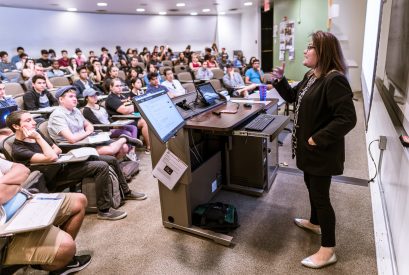The University Catalog is more what you’d call Guidelines than actual Rules.
Active Learning Tools

Why do I keep going on about making your time at Long Beach State more about Active Learning and less about Passive Learning? Because in the end, I’ve come to believe that the only way we truly learn is by doing.
We Learn By Doing
When medical school graduates head to hospitals for their Internships & Residencies, they have a slogan about new procedures that they’ve never done before:
Watch One,
Do One,
Teach One.
Have someone show you how to do it. Then do it yourself. Then teach someone else. From the chart above, Watch One is “Demonstration” – 30% retention, Do One is “Practice” – 75% Retention, Teach One is “Teaching” – 90% retention. That’s a far cry from the 5% or 10% retention that we experience from sitting in lecture after lecture or reading thick textbooks.
I believe that your education should be an active, Project Based experience. Make things!
What kinds of things?
- Business Plans
- Marketing Strategies
- Patient Rehabilitation Programs
- Engineer a Bridge, or a Circuit, or an Airplane
- Make a Movie
- Study life in the wetlands around Long Beach
- Write something you care about
- Do a Civil War Reenactment
- Organize a Concert
- Go on an awesome road trip with friends from your Dorm, or Sorority, or Sports Team, or the Anime Club, or the Salsa Club… and document the experience in your own compelling way
Education in 2018 is Upside Down
If all this active learning is so great, why isn’t the university organized that way?
Many experiences are.
In the Arts, we have “Studios” where student artists make things. In the Sciences, there are “Labs” where student scientists make things. Still, a lot of your time at The Beach is spent falling asleep in rooms like Psy-150.
Why?
The CSU system has 23 campuses and a total of five hundred thousand students. Long Beach State alone has thirty-six thousand students. It’s probably impossible for any university to come up with that many individualized programs. So we have a University Catalog that accumulates the hard work and wisdom of the university faculty over generations. It serves as a road map to your degree, and to your career, and ultimately to your life.
Fortunately for us, the University Catalog is more what you’d call Guidelines than actual Rules. If you have a vision, work with your adviser to bend those guidelines to server your career here in the 21st century.
Your Turn
This semester we’ve had people from across the LBSU campus talk to us about the ideas that I believe can empower, enrich, and energize your education. There are some photos below to remind us of their talks.
Now it’s your turn. I hope you’ll take advantage of as many options as you possibly can during your time at Long Beach State.
Honestly, creating your own program is more work than just going along with letting your adviser read the university catalog for you and tell you what classes to take.
More work, and more reward.
The roadmap in the catalog won’t be the best for some of you. For others, it might be quite good. But either way, how great an experience can you have when you spend your life following someone else’s roadmap?
Use the resources available here at The Beach to craft your own college experience. Maybe your map will be better than the catalog. Maybe it won’t. It doesn’t really matter. It doesn’t even matter if it’s the road less traveled, or the road more traveled. What matters is that when you forge your own path, it’s real, and palpable, and relevant to you. And that, I believe, will make all the difference.

1. Negotiate – with Glenn

2. Study Abroad – with Kandis Pagoda

3. Internships – with Rosa Trujillo

4. ePortfolios – with The Students of Art 110

5. Communicate – with Dominic & Natalie / 22 West Media

6. Teach – with Dr. J.

Burn the university catalog: lessons from alternative education:
My TEDxCSULB ’17 talk:

Comments? Questions? What great art did you see, make, or experience today?